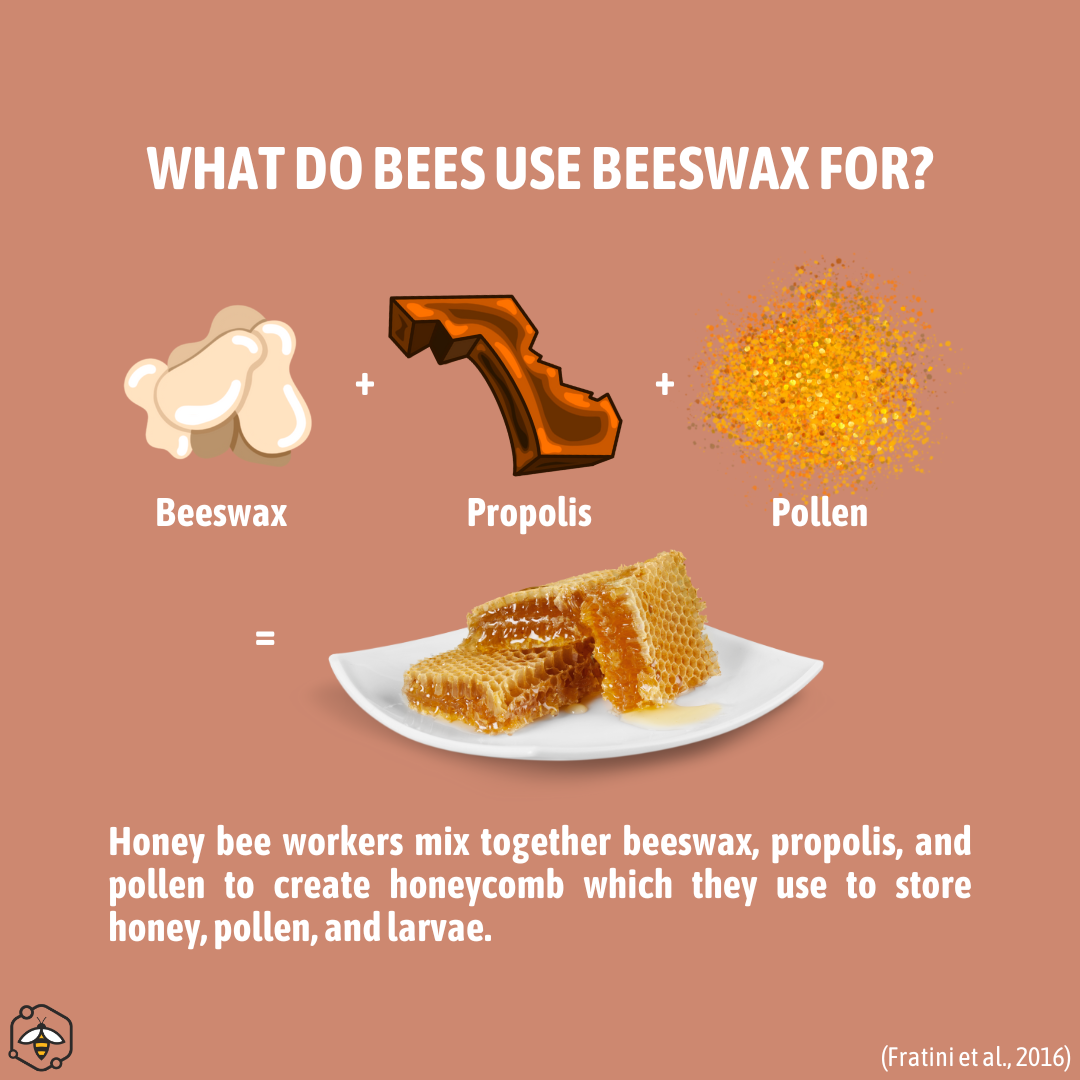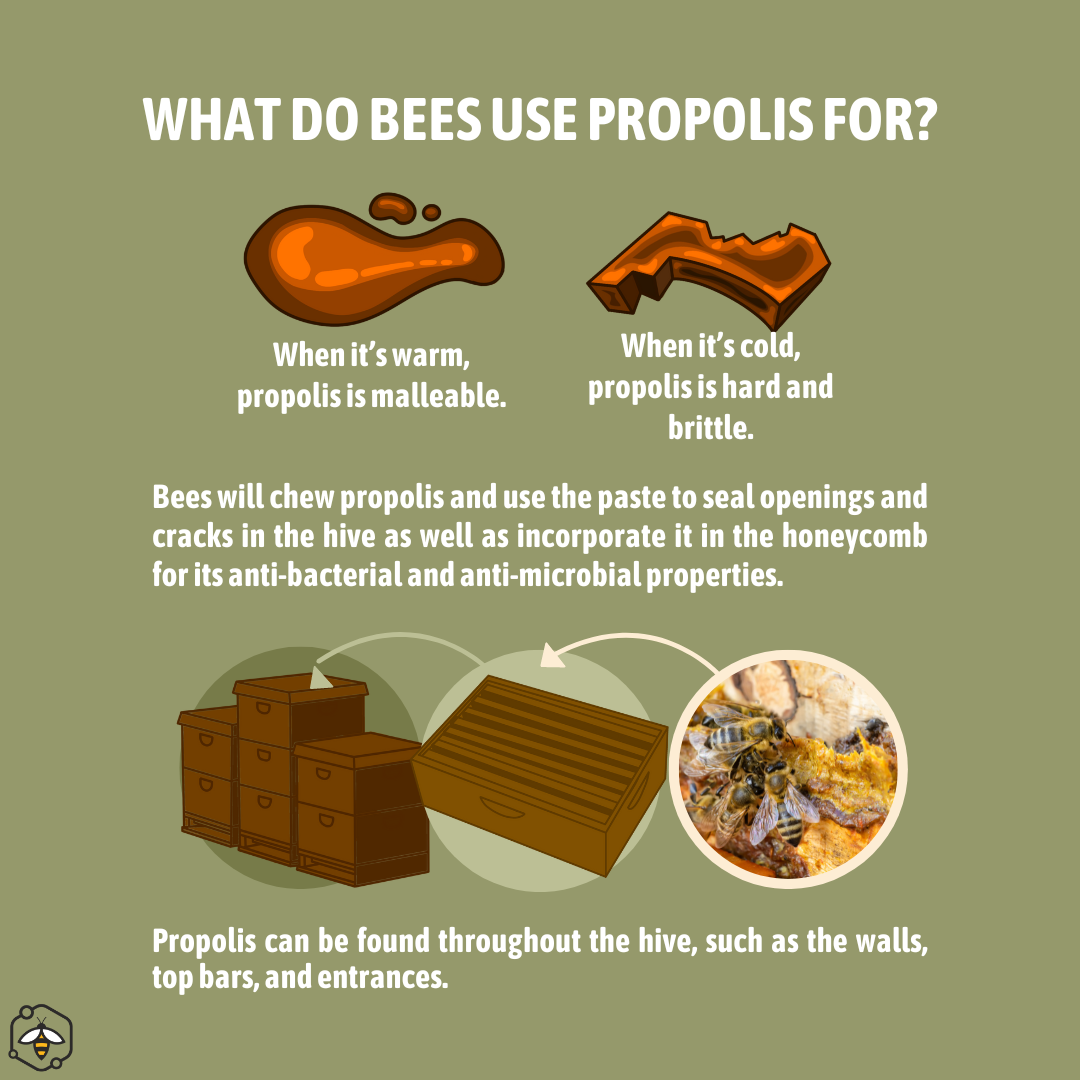Bee Products
August 2024
By Leilani Pulsifer
Honey isn’t the only bee product that humans have the privilege of benefitting from. Aside from honey, there are three primary bee products that humans make use of: beeswax, propolis, and apitoxin. While these all have their unique uses in the hive, humans have found ways to harvest and use these products as well.
Beeswax
According to Fratini et al. (2016), beeswax “...is a complex product secreted in liquid form by special wax glands in the abdomen of younger worker bees.” When exposed to air, the wax solidifies into scales which the bees can then manipulate with their mandibles. Honey bee workers mix together beeswax, propolis, and pollen to produce the material they use to form honeycombs. Honeycombs are then used to store honey, pollen, and house larvae.
Beeswax has been shown to be very beneficial for human use, too! Beeswax contains many remedial properties and can be found in a variety of products including health products, cosmetics, lotions, foods, and household materials such as beeswax wraps or candles.
Propolis
Propolis is a natural resinous mixture that is made from sap from plants (such as evergreens or various shrubs) and bee saliva (produced as the bee chews on the sap) (Burdock, 1996). When it is warm, propolis is malleable. When it is cold, propolis becomes hard and brittle. This makes it great for sealing openings and cracks in the hive. Not only this, propolis has anti-bacterial and anti-microbial properties, making it great for incorporating into the honeycomb to protect the honey! Propolis can be found all throughout the hive, especially on the walls, top bars, and entrances.
For human use, the antimicrobial component of propolis makes it a valuable constituent of various medical treatments for ailments such as upper respiratory tract infections, common colds, wound or burn treatments, and many other topical or cosmetic uses (Wagh, 2013).
Apitoxin
Apitoxin (aka bee venom), “is produced by female worker bees and is known to contain many active components...” (Wehb et al., 2019, para 3). Some of these active components are peptides, enzymes, amino acids, and volatile compounds.
Bee venom is a bee’s defense mechanism against predators and is the reason why bee stings are painful. Interestingly, lab studies show that the active components present in bee venom may play an important role in treating inflammatory and central nervous system diseases including Parkinsons Disease, Alzheimer’s Disease, Amyotrophic Lateral Sclerosis, or various forms of cancer. However, more research is needed to verify the potential use of bee venom to treat these diseases.
It’s important to note that apitoxin can induce allergic reactions! These can take place on the skin and in the respiratory system, gastrointestinal system, and cardiovascular system.
References
Burdock, G. A. (1998). Review of the biological properties and toxicity of bee propolis (propolis). Food and Chemical toxicology, 36(4), 347-363.
Fratini, F., Cilia, G., Turchi, B., & Felicioli, A. (2016). Beeswax: A minireview of its antimicrobial activity and its application in medicine. Asian Pacific Journal of Tropical Medicine, 9(9), 839-843. Doi: https://doi.org/10.1016/j.apjtm.2016.07.003.
Wagh, V. D. (2013). Propolis: A wonder bees product and its pharmacological potentials. Advances in Pharmacological Sciences, 2013. Doi: 10.1155/2013/308249
Wehbe, R., Frangieh, J., Rima, M., El Obeid, D., Sabatier, J., & Fajloun, Z. (2019). Bee venom: Overview of main compounds and bioactivities for therapeutic interests. Molecules, 24(16), 2997. Doi: 10.3390/molecules24162997
///
If you have questions about this resource, don’t hesitate to reach out to us at info@ttp-bchpa.ca or send us a DM on Instagram (@BC_TTP) or Facebook (@BC Tech Transfer Program).









